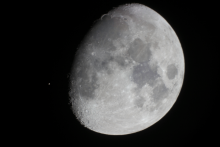Listen to today's episode of StarDate on the web the same day it airs in high-quality streaming audio without any extra ads or announcements. Choose a $8 one-month pass, or listen every day for a year for just $30.
You are here
Moon and Aldebaran
The Moon passes especially close to the bull’s bright orange “eye” tonight. Aldebaran is just an eyelash away from the Moon as they rise in late evening. Over the following hours, the Moon will pass even closer to the bright star, before they begin to pull apart.
Aldebaran looks so bright because it’s a giant star that’s close by. At visible wavelengths, it shines about 150 times brighter than the Sun.
But Aldebaran’s surface is thousands of degrees cooler than the Sun’s. Because of that, the star radiates much of its energy in the infrared — wavelengths that are too long for the eye to see. When you add that to the visible light, Aldebaran is more than 500 times the Sun’s brightness.
Although infrared energy has different wavelengths from visible light, it travels through space at the same speed: the speed of light. In fact, so do all forms of electromagnetic energy — from long radio waves to short gamma rays. So if astronomers look at a star with different kinds of telescopes at the same time, the telescopes all see the star as it looked at the same instant.
All of those wavelengths move at lightspeed — 670 million miles per hour. Yet even though Aldebaran is a close neighbor, it takes its light about 65 years to reach Earth. In other words, the star is 65 light-years away — a good example of just how vast the universe really is.
Script by Damond Benningfield



